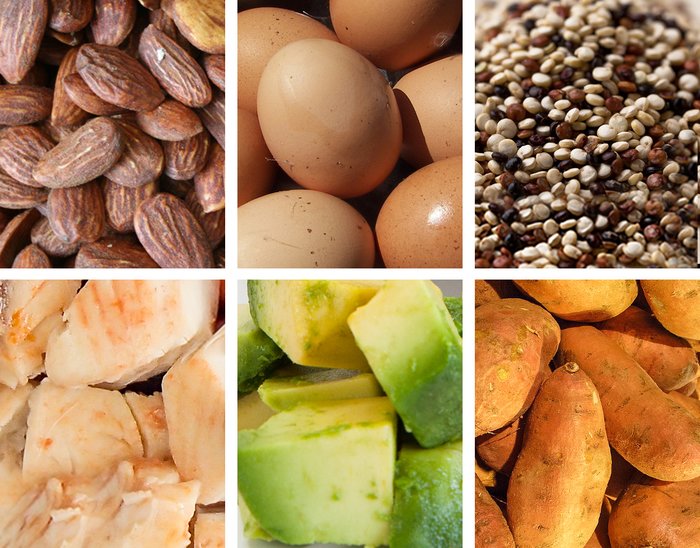You probably don't need me to tell you that if you made a New Year's resolution to lose weight, the odds are decidedly stacked against you. Twenty-five percent of people who make New Year's resolutions fail by the end of the first week, approximately a third by the end of the first month, and over half by six months. Sadly, fewer than 10 percent actually achieve some semblance of their New Year's resolution and maintain it one year later.[1]
One out of ten—and you want to be one of them. So how do you do it? Defy the odds and become one of the few who sustain meaningful progress to lose weight long-term with these four strategies that have guided plenty of people before you to the "after" they seek.
1. Don't Go To Extremes In Caloric Intake
To shoot for unreasonably high rates of weight loss, many resolution-makers resort to extremes in caloric intake. If you significantly cut calories and increase exercise, you'll absolutely lose some weight, and lose it quick! However, that fast weight loss often comes with even faster weight regain.
After a brief weight-loss honeymoon phase of 2-3 weeks, your body will adapt its metabolism to your borderline-starvation intake and marathon-like level of activity. The amount of calories you burn daily will decrease, and hunger hormones will skyrocket as a protective strategy. At this point, you will either have to reduce from an already minimal intake, or add additional cardio to your already long gym dates—both of which, are impractical. You'll also see a reduction in nonexercise activity thermogenesis (NEAT)—in other words, the activity you once did outside of the gym, but now feel too weak to manage.[2-4]

Moderately reduce calories to a point where you can lose around 1 percent of your body weight weekly, maximum.
This is what people are describing when they use the term "metabolic damage." Reductions in metabolic rate during times of caloric restriction have been observed in animals, obese humans, and even bodybuilders during contest preparation.[4-7] The more extreme the caloric deficit, the greater the potential for metabolic damage.[8]
The answer: Moderately reduce calories to a point where you can lose around 1 percent of your body weight weekly, maximum. This means that for a 250-pound man, average weekly weight loss should not be greater than 2.5 pounds weekly, and 1.5 pounds per week for a 150-pound woman. This will minimize muscle loss and metabolic damage.[9-11] When plateaus occur, make small changes, and avoid resorting to an extremely low caloric intake.
2. Avoid Fad Diets
You can spot a fad diet by its trendy name or concept, promises of results that seem too good to be true, and blaming weight gain on a single factor. Just to be clear, no single food alone has ever been shown to cause weight gain or loss when consumed in moderation.
And yet, fad diets commonly eliminate not only foods, but entire food groups or macronutrients. They may make drastic limitations on when you can eat. These diets often result in fast initial weight loss simply because, when you have fewer food sources to choose from or fewer times you can eat them, caloric intake will be significantly reduced.

Eating an appropriate amount of calories from a diet containing a variety of foods from all food groups doesn't need a trendy name.
However, these diets fail long term because they are not sustainable—nor, in most cases, should they be. In fact, they quickly begin to resemble eating disorders.[12]
The answer: Start with knowledge and control, not drastic elimination. Eating an appropriate amount of calories from a diet containing a variety of foods from all food groups doesn't need a trendy name. Start by learning nutritional principles and following a 40/30/30 macronutrient breakdown, where 40 percent of your calories come from carbs, 30 percent from protein, and 30 percent from fat. From there, you can make small adjustments to fit your lifestyle and goals.
3. Use Cardio As A Tool And Weights As Your Weapon
Spending the first couple of months of the new year on the treadmill may help you drop weight, but often, a good amount of that weight comes from muscle mass. This is especially true if you're on a reduced-calorie diet.
The tragedy here is that when weight loss is the goal, muscle is your best friend! It burns calories at rest, but even more importantly, it gives you the power to do more high-quality work in the gym and be more active and functional in all areas of your life.

Spending the first couple of months of the new year on the treadmill may help you drop weight, but often, a good amount of that weight comes from muscle mass.
Someone should study this, right? Well, they have. Research has shown that a combination of resistance training with moderate amounts of cardio is optimal for both dropping significant amounts of body fat and maintaining muscular strength and size.[13,14]
The answer: Don't listen to what people say about "getting big." Make lifting weights with an emphasis on strength and hypertrophy progression a high priority, and trust that it's helping you burn fat, because it is!
Use cardio as a tool to help create an energy deficit, but don't go overboard. Start with a couple sessions per week, including a mix of high-intensity interval training (HIIT) and moderate-intensity exercise. When the amount of cardio you do impedes the quality or progression of your strength training, you know you're doing too much.
4. Think Beyond This Year
This may seem like the antithesis of a yearly resolution, but think of it this way: Do you really want to keep making the same resolutions every year? I thought not.
The reason people fail on their drastic diets before the one-month mark is that those diets can't be followed for much longer than that. The same goes for weight-loss programs that require you to engage in boring, repetitive training for hours on end.
Are you really going to eat 1000 calories a day for the rest of your life? Are you never going to eat chocolate again for the rest of your life because it's not on your list of allowed foods? Are you going to continue to torture yourself on the treadmill when you want to be home with your family? It's unlikely, to say the least. It's likely to send you screaming back to the embrace of the couch, your favorite comfort foods, and your old way of living.
The answer: Before starting your new weight-loss plan, ask yourself if you can see yourself maintaining this approach for the next several years. If not, it likely won't give you the results you're looking for. You're looking for a lifestyle change, not a quick fix that leaves you back where you started a few months later.
You still won't simply wake up as the "new you" a year from now, though. You need to stay plugged in along the way. Here's how:

Get a workout buddy if you can, but at minimum, stay in communication with someone close about your journey to add another layer of accountability.
Write down your goals, and create weekly check-ins to you assess your progress.
- When you're not seeing the progress you want, make minor tweaks to your diet or exercise plan (not both) and reassess after a few weeks.
- Don't expect miracles. That 10 extra pounds didn't magically appear on your body in a week, so don't expect it to come off that way!
- Schedule your workouts and meal preps like any other appointment you make. Mark it in your calendar, and make it a priority.
- Schedule your workouts at the same time of day, when you know you can stick to them.
- Get a workout buddy if you can, but at minimum, stay in communication with someone close about your journey to add another layer of accountability.
One more optional tip: While it may seem like a pain at first, measuring and tracking your calorie intake is a tried-and-true way to stay on track and reach your weight-loss goals. After a while, you'll be able to eyeball serving sizes and make educated guesses about how many calories you're consuming without having to take out the food scale.
No one ever said losing weight would be easy. Actually, plenty of people did, but they were trying to sell you something. Not me. All I want is for you to stick with it and crush your goals—in that order!
References
- Statistic Brain Research Institute: New Years Resolution Statistics. 2015; Available from: www.statisticbrain.com/new-years-resolution-statistics/.
- Johnstone, A.M., Murison, S.D., Duncan, J.S., Rance, K.A. & Speakman, J.R. (2005). Factors influencing variation in basal metabolic rate include fat-free mass, fat mass, age, and circulating thyroxine but not sex, circulating leptin, or triiodothyronine. American Society for Clinical Nutrition, 82(5), 941-948.
- Trexler, E. T., Smith-Ryan, A. E., & Norton, L. E. (2014). Metabolic adaptation to weight loss: implications for the athlete. Journal of the International Society of Sports Nutrition, 11(7).
- MacLean, P. S., Bergouignan, A., Cornier, M. A., & Jackman, M. R. (2011). Biology's response to dieting: the impetus for weight regain. American Journal of Physiology-Regulatory, Integrative and Comparative Physiology, 301(3), R581-R600.
- Brownell, K. D., Greenwood, M. R. C., Stellar, E., & Shrager, E. E. (1986). The effects of repeated cycles of weight loss and regain in rats. Physiology & Behavior, 38(4), 459-464.
- Johannsen, D. L., Knuth, N. D., Huizenga, R., Rood, J. C., Ravussin, E., & Hall, K. D. (2012). Metabolic slowing with massive weight loss despite preservation of fat-free mass. The Journal of Clinical Endocrinology & Metabolism, 97(7), 2489-2496.
- Knuth, N. D., Johannsen, D. L., Tamboli, R. A., Marks-Shulman, P. A., Huizenga, R., Chen, K. Y., ... & Hall, K. D. (2014). Metabolic adaptation following massive weight loss is related to the degree of energy imbalance and changes in circulating leptin. Obesity, 22(12), 2563-2569.
- Rossow, L. M., Fukuda, D. H., Fahs, C. A., Loenneke, J. P., & Stout, J. R. (2013). Natural bodybuilding competition preparation and recovery: a 12-month case study. International Journal of Sports Physiology and Performance, 8(5), 582-92.
- Helms, E. R., Aragon, A. A., & Fitschen, P. J. (2014). Evidence-based recommendations for natural bodybuilding contest preparation: nutrition and supplementation. Journal of the International Society of Sports Nutrition, 11(1), 20.
- Garthe, I., Raastad, T., Refsnes, P. E., Koivisto, A., & Sundgot-Borgen, J. (2011). Effect of two different weight-loss rates on body composition and strength and power-related performance in elite athletes. International Journal of Sport Nutrition and Exercise Metabolism, (21), 97-104.
- Mero, A. A., Huovinen, H., Matintupa, O., Hulmi, J. J., Puurtinen, R., Hohtari, H., & Karila, T. A. (2010). Moderate energy restriction with high protein diet results in healthier outcome in women. Journal of the International Society of Sports Nutrition, 7(4), 1-11.
- Stewart, T. M., Williamson, D. A., & White, M. A. (2002). Rigid vs. flexible dieting: association with eating disorder symptoms in nonobese women. Appetite, 38(1), 39-44.
- Clark, J. E. (2015). Diet, exercise or diet with exercise: comparing the effectiveness of treatment options for weight-loss and changes in fitness for adults (18-65 years old) who are overfat, or obese; systematic review and meta-analysis. Journal of Diabetes & Metabolic Disorders, 14(1), 31.
- Glowacki, S. P., Martin, S. E., Maurer, A., Baek, W., Green, J. S., & Crouse, S. F. (2004). Effects of resistance, endurance, and concurrent exercise on training outcomes in men. Medicine and Science in Sports and Exercise, 36, 2119-2127.

